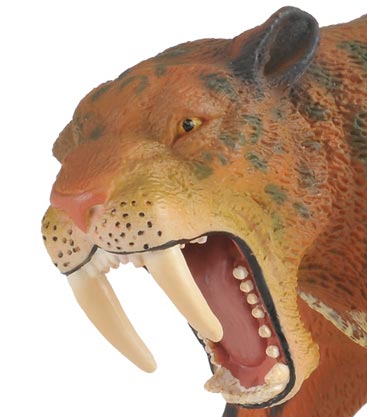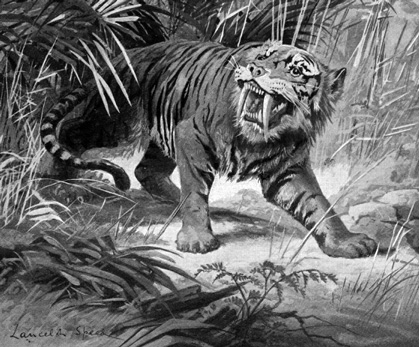How Smilodon Got Its Stripes
The Misleading Sabre-Toothed Tiger – How did Sabre-Toothed Cats become Tigers?
As team members are busy helping out at an exhibition featuring Ice Age creatures, it seems appropriate this weekend to raise the issue of the misleading term often applied to Sabre-toothed cats. These extinct predators are often referred to as “Sabre-toothed tigers”, although such animals are not related to modern, extant tigers.
Smilodon
Smilodon fatalis – Sabre-Toothed Cat
Picture credit: Everything Dinosaur
Although, the likes of S. fatalis and Smilodon populator are member of the Felidae (cat family) they are classified as members of the Machairodontinae, whilst extant tigers, lions, leopards, today’s “big cats” are ascribed to the Pantherinae. Sabre-tooths are not closely related to tigers.
A spokesperson from Everything Dinosaur commented:
“Often these animals are referred to as Sabre-toothed tigers, we do use this terminology in order to assist customers with queries, orders and with product searches but the name is confusing and when asked we do our best to explain the differences between the machairodonts and other large felid predators.”
For dinosaur and prehistoric animal models and figures including Smilodon figures (whilst stocks last): Rebor Replicas and Models.
Sabre-Toothed Tiger?
How the term Sabre-tooth tiger came about, is something of a mystery. Staff at Everything Dinosaur have discussed this, but none of us can provide a definitive answer. However, a clue to the origin of the term may lie in a painting of a prehistoric cat.
Many of the Sabre-toothed cats were first scientifically studied and described in the mid 19th century, genera like the Machairodus which was erected in 1832 and Smilodon which was established in 1846. Many leading figures in Victorian society were keen to champion the sciences, especially the relatively new sciences of palaeontology and geology. As natural history museums were built to house ever-growing national collections, so fossils of prehistoric cats began to be put on display.
To help illustrate these exhibits a number of artists produced paintings in an attempt to depict these creatures. The colouration of Sabre-tooth cats remains open to speculation, these predators lived in a variety of habitats from open plains, bush country and forested areas. It is likely that a number of species had widely varying coats, perhaps even stripes like a tiger.
Lancelot Speed
One famous British artist and illustrator, Lancelot Speed (1860-1931) produced an illustration in 1905 that depicted Machairodus with stripes. With all the big game hunting going on in what was now the Edwardian era, perhaps Speed was influenced by tiger hunting in India. Whatever the reason, his magnificent picture depicting a striped Sabre-toothed cat might be the reason why the phrase “Sabre-toothed tiger caught on with the public.
Machairodus Illustrated by Lancelot Speed
The Sabre-toothed cat in the illustration is very much like a tiger, the artist has even given this big cat white flashes over the eyes reminiscent of a Bengal Tiger (Panthera tigris tigris), the most numerous of all the tiger sub-species left on Earth today. Perhaps it was popular depictions of striped Sabre-tooths such as the painting above that led to the adoption of the term “Sabre-toothed tiger”, even though it is scientifically inaccurate.
Visit Everything Dinosaur’s award-winning website: Visit Everything Dinosaur.



